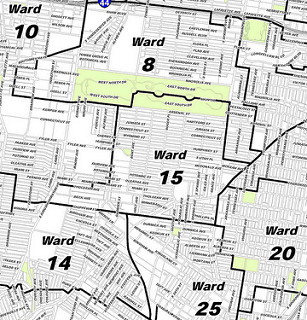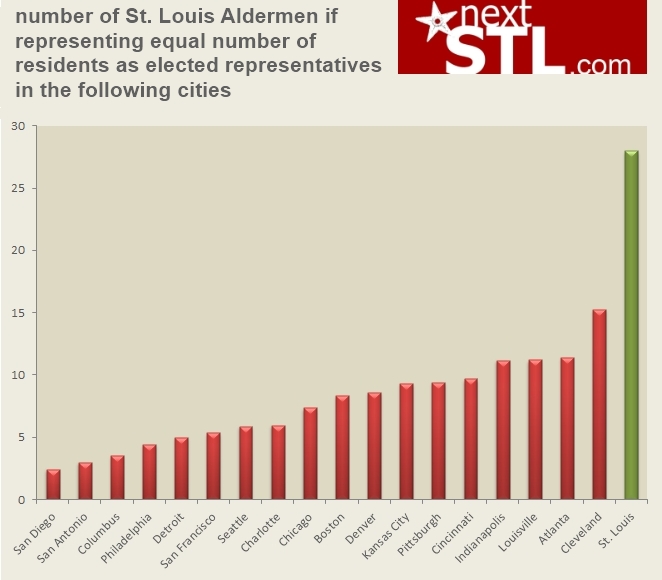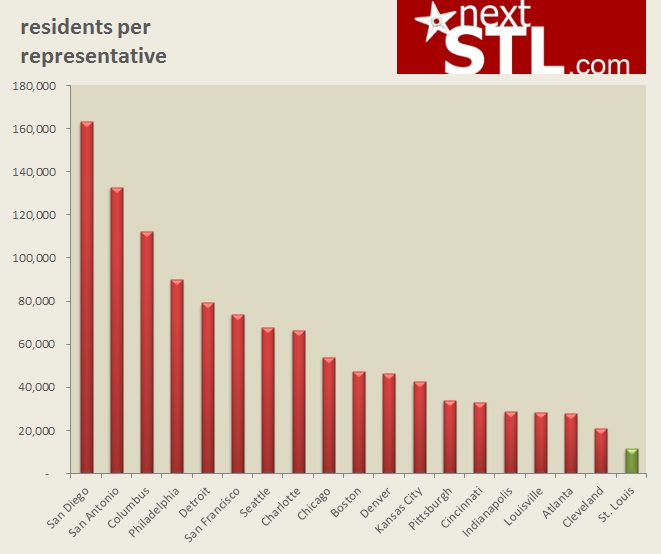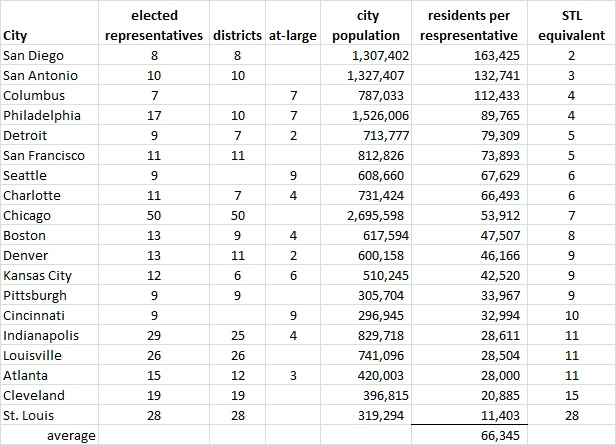 Reducing the number of elected representatives in the City of St. Louis is not an end unto itself, it’s a means toward seeking more responsible, more accountable government. As a City of St. Louis resident 27/28 of the Board of Aldermen do not answer to you. An individual outside their ward, almost 307,000 people do not count as a constituent.
Reducing the number of elected representatives in the City of St. Louis is not an end unto itself, it’s a means toward seeking more responsible, more accountable government. As a City of St. Louis resident 27/28 of the Board of Aldermen do not answer to you. An individual outside their ward, almost 307,000 people do not count as a constituent.
If the current number of Aldermen is serving city residents well, how does one explain the current state of the City of St. Louis? Tens of thousands of residents continue to leave every decade, 1 in 5 properties are vacant, murder and violent crime are unacceptably high and the school system is unaccredited. And if Aldermen are not primarily responsible for issues such as these, then why have 28? It’s well past time that the city hit the panic button and try something new. What’s to lose? Another 29K residents?
The issue isn’t only about the dwindling number of residents each Alderman represents, though perversely, the more residents a ward loses, the larger footprint in the city that Alderman controls as a result of redistricting. The system today favors current Aldermen and the larger entrenched political status quo as it severely limits those who may run for the office. The pool of potential candidates for each ward is debilitatingly small. Wards of approximately 12,000 residents struggle to find competent and energetic candidates for office. The salary of ~$37K precludes others from considering running for office, severely limiting competition for the office. Who does the status quo serve? A smaller Board of Aldermen is also about getting the best candidates to run for public office.
Today, no one has effective authority to speak for the larger city. The office of the Mayor is politically weak by design. Aldermanic courtesy, a vacuum in leadership and basic inept governance result in what is in effect 28 municipalities. The fragmented system has meant that Aldermen are answerable to only a very small handful of city residents, as they are often elected with only several hundred votes. This must change, but the Board of Aldermen as a political body is structured to be unresponsive. Just half of the board is up for election each cycle. Optimistically it would take several election cycles to substantially change the composition of the Board. Again, this situation only serves the entrenched interests in our city.
How does an Alderman evaluate the merits of a Tax Increment Financing or Community Improvement District bill or other development issue in another Ward? In reality, they don’t. In St. Louis this is called Aldermanic “courtesy” – a principle that states, I’ll ignore what you do in your ward if you ignore what I do in mine. This, by design, precludes any city-wide conversation, decision, or leadership on issues such as historic preservation, development, tax subsidies, housing, traffic, and other issues. Residents of the city are connected economically, spatially and socially, but not politically.
What is a resident to do if they object to the Board of Aldermen passing a $391M TIF plan for the NorthSide Regeneration effort? The majority of the project is in the city’s 5th Ward. The Alderwoman supports it. Does anyone dedicate themselves to running against their own Alderman who voted to support a massively subsidized project in another ward? No. It’s simply a degree too far removed to engage residents. There’s no shared responsibility.
We ignore that we live in a city, and not just a ward. When 19th Ward Alderwoman Marlene Davis recently introduced a bill that would give the owner of the “flying saucer” building in Midtown the option to demolish it, she was genuinely surprised by the opposition that emerged, even asking why other aldermen were suddenly interested in her ward when they had passed similar bills for their ward without objection.
As reported by the Post-Dispatch, Phyllis Young, Alderwoman for downtown, Soulard and Lafayette Square, is set to introduce a bill at Friday’s board meeting that would cut the number of city wards to 12 from 28. The bill currently has 10 co-sponsors (Stephen Conway, Alfred Wessels, Carol Howard, Jennifer Florida, Donna Baringer, Joseph Roddy, Marlene Davis, Scott Ogilvie, Shane Cohn and Lyda Krewson) and requires 15 votes to pass the Board. Current Aldermanic support is heavily weighted toward South St. Louis.
Why has nothing been heard from the majority of Aldermen representing North St. Louis? Do they think that their constituents have been particularly well served by the status quo? Do they imagine themselves as the protector of what’s left, a severely stressed and eroding part of a city, itself in demise? It would appear that Aldermen north and south prefer to fight over what’s left than seek to serve the city as a whole.
St. Louis is a city that should not be held hostage by political machinations or historic grievances. The north-south split serves exactly no one and does nothing to create a better city. Some aldermen are most concerned with hyping efforts to protect their 1/28th of the shrinking city against the other 27 wards. Even often referred to “progressive” representatives bury their heads within their ward boundaries out of political necessity. And even then, very few aldermen can be labeled “progressive”.
As a transplant to St. Louis more than eight years ago, I had no care into which ward I moved. No one does. Not transplants, not businesses, not institutions. That is, until they realize that an Alderman in the City of St. Louis is akin to a feudal lord. In fact, it was probably four years into my life here before I could answer that I lived in the 17th Ward of the City of St. Louis. The first time I heard my Alderman’s name? An elderly woman asked me to vote for him on election day as we passed each other in the hallway. “His father was a good man,” the woman said.
Effective governance is the goal. Why is there no discussion of how other cities operate? Cincinnati, Indianapolis, Louisville, Columbus, Kansas City? Do Aldermen here somehow think that residents of those cities are particularly poorly served? Do trees that fall in those cities simply remain on the ground indefinitely? Do residents wander about in despair with no recourse and idea as to when (and if?) a fallen tree may be removed?

Looking at other cities provides a stark contrast. The chart above shows the number of Aldermen in St. Louis if they represented the number of constituents as do elected representatives in each of the listed cities. If St. Louis were San Diego, we would have two Aldermen. Columbus? Five. Charlotte? Six. Chicago? Seven. Pittsburgh? Nine. While there may not be anything inherently superior or inferior to the number of representatives a city has, can anyone say that the status quo in St. Louis has served us well?
And the author of the bill? If and when this effort fails it will be due to ineffective, inarticulate and misguided proponents. The best, perhaps only, argument offered by 7th Ward Alderwoman Phyllis Young was that trimming the Board would save the city perhaps $600,000 per year. And so an opponent of reducing the number of the Board, 23rd Ward Alderman Joe Vaccaro can happily ignore all other issues and attack the rather irrelevant potential cost savings.
When asked “why are you doing this” on a recent St. Louis on the Air program, Young leaned on cost savings and the city budget challenges as a primary justification. She stated that the idea of cutting the size of the board come up again during the city’s budget process. Young then said that the financial savings are a “drop in the bucket” and that the number of proposed wards, 12, was “pulled out of a hat”. She’s the wrong advocate for the proposal.
One can only conclude that the effort to reduce the number of Aldermen in the City of St. Louis is not a serious effort. Where is the research? Where are the arguments to support the initiative? Where’s the groundwork to create a movement to support the idea?
The conversation regarding the number of Wards (and Aldermen) in the City of St. Louis, so far, is based on a completely false premise; that nothing would change other than an increase in the number of constituents per ward.
Nothing changes until the mindset of city of government changes. What’s clear is that the public proponents and opponents of this effort confine themselves to a mental box. During the same St. Louis on the Air segment, 23rd Ward Alderman Joseph Vaccaro remarked incredulously when considering what it would mean to serve a larger ward, “My concerns are, having done the job, that the person who would take my place, I would expect him to do everything I did and in the way that I did it. I just don’t know how possible it would be. I’m sure people would try, but it’s not possible.”
You should listen to the entire segment, but Vaccaro goes on to state:
Let’s just say for instance, if your trash didn’t get picked up today, it was on the route, but for whatever reason they missed it, and this happens. If you call the Citizens Service Bureau because you cannot call the refuse department directly, they will tell you they have 10 days to get back to you. 10 days. It will already be picked up by then. If I call, at least I can talk to the head of the refuse department and he gets someone out there today. I can let them know when that’s going to happen.
The other day 160, roughly, people called me because trees fell down in the neighborhood. They could have called the Citizen Service Bureau and (Alderwoman Young) is right, did I have a chainsaw? No. But I did have the ability to talk to the Forestry Department so that I could tell people, “look, they’re working over on this block, they are going to get this. I was able to let people know in a timely fashion what was going to happen, how it was going to happen, what was going on, what areas they were taking care of.
More from Vaccaro, “(my constituents) rely on being able to call us on the phone and say, ‘Hey, Joe, I have a problem.’ ” In personal relationships this is called dependent personality disorder and is described as a pervasive and excessive need to be taken care of that leads to a submissive and clinging behavior as well as fears of separation. If my Alderman doesn’t call the city and double-check that trash is going to be picked up, who will? This is what is at work against any effort to modify the status quo in St. Louis.
“Why should (residents) have to call the Citizens Service Bureau for instance,” Vaccaro asks. “I give my cell phone number to every person in the ward and encourage them to call me for faster service.” Handing out your phone number is politically smart. Doing so means that the Alderperson becomes the locus of power in a city neighborhood, ensuring their self-defining necessity. At this point, Mr. Vaccaro is doing his best Tom Smykowski. Who? Tom is the Initech employee in the movie Office Space who attempts to justify his job as a go-between to hired consultants.
And Alderman Vaccaro is by just about any measure a sincere, dedicated public servant who works hard to serve his constituents. He is not the problem, but the system he works hard to justify is. If one wasn’t familiar with the particular dysfunction of City of St. Louis governance, you could be excused for thinking this conversation was a parody of real life.

What should be done? The average number of constituents represented by elected officials of city districts in the cities listed above is roughly 66,000. In St. Louis, that would translate to five Aldermen. The City would be divided into five wards. To that, add two representatives elected at-large to give a voice to the city as a whole. Seven Aldermen. They don’t take phone calls about dirty alleys or fallen trees. If they do, they direct residents to the Citizens Service Bureau, an office designed to address such things. They don’t decide to close streets, that’s the City Streets Department. They don’t choose which buildings to permit or demolish. That’s the City Building Division (or the Cultural Resources Office).
Simply reducing the number of Aldermen in and of itself will not create a better city, but thinking like a city, having elected officials responsible for the city (or at the very least much larger portions of it) is undeniably positive. Opponents of reducing the number of Aldermen must be required to explain how the status quo best serves ward residents and the city as a whole.
Of course, it’s an idea that isn’t going to happen. North Side aldermen will raise the specter of racial discrimination. The senior citizens of the South Side will fear entering a new number for a faceless city department into their Jitterbug cell phone, and the newcomers landing in the central corridor will remain blissfully unaware. And then Aldermen will go on air and ask how anyone could possibly do five times the work they currently do. Until the false premise of governance in the City of St. Louis is flipped, until the straightjacket of dependent personality disorder is loosened, nothing will change.


